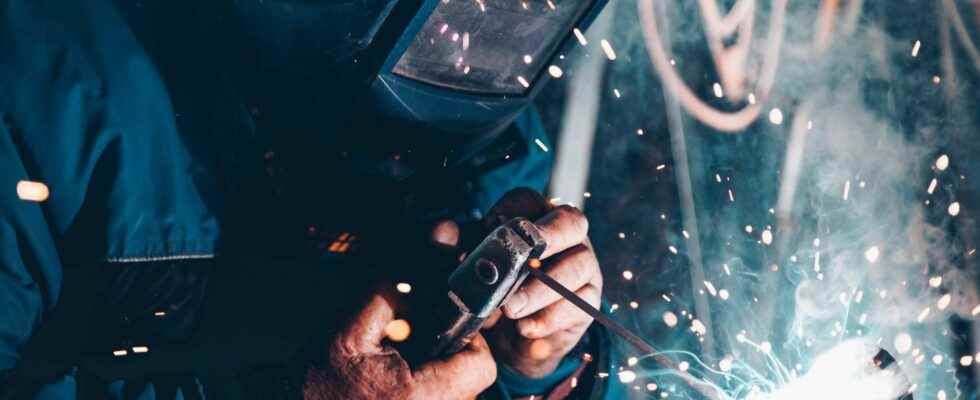We don’t dare tell him, for fear of paralyzing him. Squatting facing the breach, welding mask raised on his head and welding torch in his right hand, does Jawad Zaroual measure the expectation that weighs on his shoulders? Installed in a training box in the temporary premises of the High School for training in welding professions in Cherbourg (Hefais), he perfected his welding technique, under the watchful eye of his trainer Dominique Y-Tot. Blow of the torch, then passage of a metal brush over the welding point, return to the torch… The gesture is precise, expert. “It’s a lot of technique. I already knew how to weld when I arrived, but here I’m learning to redo my gesture, make up for my mistakes”, he explains.
Each weld will be scrupulously examined with X-ray shots. This employee of Onet Technologies – a subcontractor of EDF -, is one of the 40 welders, including around twenty job seekers, who will have followed in 2022 the training provided by Hefais, which officially opened its doors. on September 29 and will take up permanent residence in 2023 in brand new premises.
An institution that borrows its name from Hephaestus, god of the forge and metallurgy, and whose mission has accents, it must be said, almost Herculean. Like many blue-collar workers, in a France which today seeks to revitalize its industry after having allowed it to wither away, the French welder has become a rare and therefore coveted species. EDF will not say otherwise. Faced with a heavy workload on its nuclear fleet with maintenance operations as well as the repair of circuits affected by microcracks – the famous phenomenon of stress corrosion -, the electrician had no choice but to s hire the services of a hundred American welders at the end of the summer to take on this extra work. Unprecedented and revealing of the underlying tensions in the profession. In the longer term, the construction sites of the future EPRs desired by the executive will also increase the need for welders. “Today, we work with 500 welders each year. But by 2030, recruitment will almost double and increase from 800 to 1,000” indicates David Le Hir, director at EDF of the Flamanville 1 and 2 power plant, but also president of Hefais.
“For five years, we no longer find welders”
Little wonder, therefore, to find the electrician among the founding members of the school with Orano (ex-Areva). Two atomic groups, to which Naval Group and Constructions Mécaniques de Normandie are moored, the needs of the naval industry being also important. At full capacity, the school should train nearly 200 welders each year, including 60 in the process of professional retraining. The others, already employees of the metallurgy, having to improve their skills. For these four companies, as well as their myriad of service providers, Hefais must thus provide a breath of fresh air. “For five years, we have not found welders, boilermakers, valve makers. We are in full development, we would need between 40 and 50 more people to respond to calls for tenders”, testifies Sébastien Cuquemelle, president of the group. Probent, a company with 180 employees, including 20 welders. “We have identified 7,000 offers for welding positions at Pôle Emploi. At the national level, there is a colossal demand”, figures for his part Corentin Lelièvre, director of the school.
Of course, the future of tricolor welding does not rest entirely on Hefais, whose cost of 10 million euros is borne by the founding members as well as several communities. Other schools provide training. Some groups, like Probent, also try to train the resource internally. The EDF group itself is considering creating a sector of welders for its own needs. However, this approach is far from ideal. “Our core business is not training, which requires equipment and dedicated teams, but above all intervention with our customers”, explains Sébastien Cuquemelle from Probent. Quite the opposite of the Norman school.
“We have state-of-the-art equipment, including virtual reality simulators, experienced trainers, real-scale models as well as 30 reconstructed environments such as nuclear power plant areas,” said Corentin Lelièvre. The objective being above all to guarantee at the end of the nine months of training a perfect mastery of the technical gesture for the welders and the ability to intervene on all terrain with the knowledge of the good procedures. “Given the lack of resources compared to the volume of activity, we can no longer afford to miss and redo welds, insists Sébastien Cuquemelle. The idea is really to do it right the first time.”
Restore the image of the industry
The maxim, repeated ad nauseam by EDF as part of its plan to regain operational excellence (called Excell), has in any case been well retained. But it will take more than slogans to rediscover the full extent of the resource, both quantitatively and qualitatively. Providers, on the front line in the face of difficulties, know this well. “We must restore the image of the industry and dust off its image, including within the National Education. For fifteen to twenty years, communication has been generally negative around these professions, while they are on the rise “, notes Sébastien Cuquemelle.
An attractiveness that cannot also ignore the salary issue. Faced with the obvious tension in the sector, the hardship of the work as well as the qualifications required of these workers, we say to ourselves that the latter must legitimately be able to claim attractive remuneration. Corentin Lelièvre quickly puts an end to the illusion: “The lack of welders has not particularly reinforced the rate of pay in recent years. A welder who leaves training receives on average up to 1,800 euros gross.” Unattractive. The boss of Probent nuances. “It’s the basic salary. You have a whole series of travel, outfit and mask bonuses which inflate the remuneration. A good welder can claim much higher remuneration. And this has been increasing in recent months. .” Enough to create a real draft?
